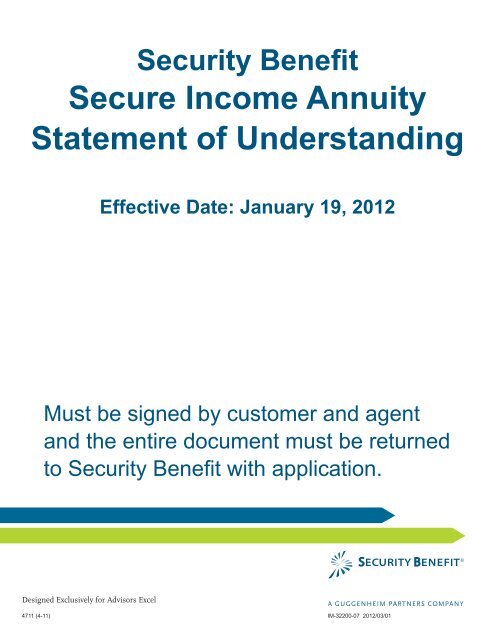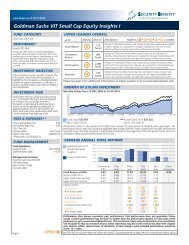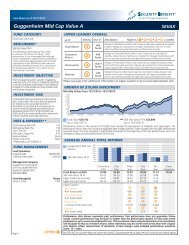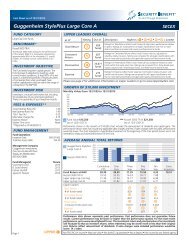Secure Income Annuity Statement of Understanding - Total Value ...
Secure Income Annuity Statement of Understanding - Total Value ...
Secure Income Annuity Statement of Understanding - Total Value ...
Create successful ePaper yourself
Turn your PDF publications into a flip-book with our unique Google optimized e-Paper software.
Security Benefit<strong>Secure</strong> <strong>Income</strong> <strong>Annuity</strong><strong>Statement</strong> <strong>of</strong> <strong>Understanding</strong>Effective Date: January 19, 2012Must be signed by customer and agentand the entire document must be returnedto Security Benefi t with application.®Designed Exclusively for Advisors Excel4711 (4-11)IM-32200-07 2012/03/01
Security Benefit <strong>Secure</strong> <strong>Income</strong> <strong>Annuity</strong><strong>Statement</strong> <strong>of</strong> <strong>Understanding</strong>Thank you for your interest in the <strong>Secure</strong> <strong>Income</strong> <strong>Annuity</strong> from Security Benefit Life Insurance Company. It isimportant for you to read this summary before you decide to purchase the annuity. This summary will help youunderstand the features <strong>of</strong> the annuity and determine if it will help you meet your financial goals. Once you haveread this summary, please sign the last page to confirm that you understand the annuity and submit thisdocument with your application for the annuity and the <strong>Annuity</strong> Suitability Form.For more specific information, please refer to the annuity contract as it contains the terms <strong>of</strong> the annuity.What is the <strong>Secure</strong> <strong>Income</strong> <strong>Annuity</strong>?The <strong>Secure</strong> <strong>Income</strong> <strong>Annuity</strong> is a flexible premium, deferred fixed index annuity with a premium bonus, surrendercharge, market value adjustment (the market value adjustment does not apply in all states), and bonus recapture.The surrender charge, market value adjustment, and bonus recapture apply for 10 contract years. Therefore, the<strong>Secure</strong> <strong>Income</strong> <strong>Annuity</strong> should only be purchased with funds that are not expected to be needed in the next 10contract years. The <strong>Secure</strong> <strong>Income</strong> <strong>Annuity</strong> is designed to be held for the long-term.What do I pay for the <strong>Secure</strong> <strong>Income</strong> <strong>Annuity</strong>?To purchase the <strong>Secure</strong> <strong>Income</strong> <strong>Annuity</strong>, you must pay an initial amount or Purchase Payment. The minimuminitial Purchase Payment is $25,000. As a flexible premium annuity, you may make subsequent PurchasePayments to the annuity in any amount and at any frequency, subject to the limits described in your contract.What is the Bonus?For all Purchase Payments we receive in the first contract year, we add a Bonus to the Account <strong>Value</strong>. TheBonus is equal to the Purchase Payment we receive in the first contract year multiplied by the Bonus rate. TheBonus rate depends on in what state you purchase the annuity.All states other than those listed below 8%California 7%Alaska, Indiana, Maine, Minnesota, Missouri, Nevada, 5.5%New Hampshire, New Jersey, Ohio, Oregon,Pennsylvania, South Carolina, Texas, Utah, WashingtonBonus annuities, such as the <strong>Secure</strong> <strong>Income</strong> <strong>Annuity</strong>, may include changes to the elements used todetermine the index interest credits or changes to the interest rate that are not included in similarannuities without a bonus. These changes may include lower current interest rates, higher surrendercharges, longer surrender charge periods, lower participation rates or caps, higher spreads, or otherchanges. The amount <strong>of</strong> charges or reduction in interest credits may exceed the amount <strong>of</strong> the bonus.Can I change my mind after purchasing the <strong>Secure</strong> <strong>Income</strong> <strong>Annuity</strong>?Yes. Many states have laws that give you a specific number <strong>of</strong> days to review an annuity after you buy it. If youdecide during that time that you do not want the annuity, you can return it and receive your entire PurchasePayment returned. Read the cover page <strong>of</strong> your contract to learn about your free look period. If this contractreplaced a previous annuity contract owned by you, the free look period may be different than that listed on thecover page <strong>of</strong> your contract (varies by state). If so, there will be an additional notice for the free look period thatwas included with your contract.4711 (4-11) 1 <strong>of</strong> 12 IM-32200-07 2012/03/01
How is interest credited under the <strong>Secure</strong> <strong>Income</strong> <strong>Annuity</strong>?Under the <strong>Secure</strong> <strong>Income</strong> <strong>Annuity</strong>, you select how we credit interest by choosing among the Fixed Account andthe available Index Accounts. Currently, there are two Index Accounts <strong>of</strong>fered – the Annual Point to Point IndexAccount and the Monthly Sum Index Account, both <strong>of</strong> which credit interest based upon the S&P 500® withoutdividends. While interest is based upon the S&P 500, you are not investing in the S&P 500 or any equitysecurities. You may choose to allocate your initial Purchase Payment among the Fixed Account and IndexAccounts in whole percentages.What is the Fixed Account interest rate?At the beginning <strong>of</strong> each contract year we declare an interest rate that will apply for that contract year. The FixedAccount interest rate will at least equal the guaranteed minimum interest rate (GMIR). At the time we issue yourcontract, we set the GMIR and it will be shown in your contract. The GMIR will be at least 1%. Interest is crediteddaily on the Fixed Account.What is the Index Account interest rate?For each Index Account, we determine the index interest rate at the end <strong>of</strong> each contract year that applies for thatcontract year. The minimum index interest rate for each Index Account is 0%. The index interest is credited onlyon a contract anniversary or if we make a payment due to death.How is the Annual Point to Point Index Account interest computed?For the Annual Point to Point Index Account, we compute the interest rate each contract anniversary basedupon the change in the S&P 500 index over the contract year, not including dividends. For each contract year,the closing value <strong>of</strong> the S&P 500 index on the first day <strong>of</strong> the contract year is the beginning value and theclosing value <strong>of</strong> the S&P 500 index on the following contract anniversary is the ending value. Accordingly, theending value for one contract year will be the beginning value for the next contract year. If the S&P 500 indexvalue is not available for any day, we use the closing value on the previous available day.We compute the difference in the beginning and ending values for the contract year by subtracting thebeginning values from the ending values. If the difference is positive, we divide that difference by the contractyear's beginning value to determine the percentage change in the S&P 500 for the year. We then comparethe percentage change to the Cap and use the lower <strong>of</strong> the percentage change or the Cap as the interestrate. If the difference in the beginning and ending values is negative, the interest rate is 0%.The Cap is the maximum rate <strong>of</strong> interest that we will credit for the Annual Point to Point Index Account. At thetime we issue your contract, we set the initial Cap and the guaranteed Cap and they are shown in yourcontract. The current guaranteed Cap is 3%. Each contract year we may change the Cap, but it will never beless than the guaranteed Cap.For example, assume that (i) JoAnn's contract is issued on February 1, 2011, (ii) the Annual Point to PointIndex Account <strong>Value</strong> on February 1, 2011 (the beginning <strong>of</strong> the contract year) was $100,000, (iii) nowithdrawals were made during the contract year, (iv) the Cap is 5%, (v) the value <strong>of</strong> the S&P 500 indexon February 1, 2011 was 1,000, and (v) the value <strong>of</strong> the S&P 500 index on February 1, 2012 (the end <strong>of</strong>the contract year) was 1,100, then:Difference in S&P 500index value=S&P 500 indexending value-S&P 500 indexbeginning value100 = 1100 - 1000Because the difference is positive, we determine the percentage change as follows:Percentage changein S&P 500 index value=Difference in S&P 500index value÷S&P 500 indexbeginning value10% = 100 ÷ 10004711 (4-11) 2 <strong>of</strong> 12 IM-32200-07 2012/03/01
We then compare the percentage change to the Cap and use the lower <strong>of</strong> the two. Since the 5% Cap islower than the 10% change in the S&P 500 index value, the index interest rate for the Annual Point toPoint Index Account for the year would be 5% and the index interest would be $5,000. Thus, JoAnn'sending Annual Point to Point Index Account <strong>Value</strong> would be $105,000.This example is only to show how the Annual Point to Point Index Account interest is computed and doesnot reflect what the interest would be for your annuity.How is the Monthly Sum Index Account interest computed?For the Monthly Sum Index Account, we compute the interest rate based upon the sum <strong>of</strong> the monthlychanges in the S&P 500 index over the contract year, not including dividends. For each month <strong>of</strong> the contractyear, the closing value on the first day <strong>of</strong> the month is the beginning value and the closing value on the sameday <strong>of</strong> the next month (if that day does not occur for the month, then the last day <strong>of</strong> the month is used) is theending value. For each month, last month's ending value is the current month's beginning value. Accordingly,the ending value for one month will be the beginning value for the next month. If the S&P 500 index value isnot available for any day, we use the closing index value on the previous available day.We compute the difference in the beginning and ending value for each month <strong>of</strong> the contract year bysubtracting the beginning values from the ending values. Next, we divide that difference by the month'sbeginning value to determine the percentage change in the S&P 500 for each month. If the difference ispositive, we compare the percentage change to the Monthly Cap and use the lower <strong>of</strong> the monthly percentagechange or the Monthly Cap as the monthly change. If the difference is negative, no Monthly Cap applies as afloor to limit the negative difference. Thus, negative changes may have a greater impact on the interest ratecomputation than positive changes. We then sum all the capped monthly changes for the contract year. If thesum is positive, it is used as the interest rate. If the sum is negative, the interest rate is 0%.The Monthly Cap is the maximum monthly change that is used in computing the sum <strong>of</strong> the monthlychanges. At the time we issue your contract, we set the initial Monthly Cap and the guaranteed Monthly Capand they are shown in your contract. The current guaranteed Monthly Cap is 1%. Each contract year we maychange the Monthly Cap, but it will never be less than the guaranteed Monthly Cap.For example, assume that (i) Bill's contract was issued on November 3, 2011, (ii) the Monthly Sum IndexAccount <strong>Value</strong> on November 3, 2011 (the beginning <strong>of</strong> the contract year) was $100,000, (iii) nowithdrawals were made during the contract year, (iv) the Monthly Cap is 2%, and (v) the monthly changesin the S&P 500 index value over the contract year are:IndexDate Index <strong>Value</strong>11/3/2011 1184.38Monthly %DifferenceApplyMonthlyCapCappedMonthlyChange %12/3/2011 1221.33 3.12% 2.00% 2.00%1/3/2012 1195.20 -2.14% - -2.14%2/3/2012 1227.11 2.67% 2.00% 2.00%3/3/2012 1235.45 0.68% - 0.68%4/3/2012 1247.31 0.96% - 0.96%5/3/2012 1183.45 -5.12% - -5.12%6/3/2012 1232.80 4.17% 2.00% 2.00%7/3/2012 1268.43 2.89% 2.00% 2.00%8/3/2012 1252.45 -1.26% - -1.26%9/3/2012 1230.78 -1.73% - -1.73%10/3/2012 1256.75 2.11% 2.00% 2.00%11/3/2012 1271.58 1.18% - 1.18%Sum <strong>of</strong> Capped Monthly Changes2.57%4711 (4-11) 3 <strong>of</strong> 12 IM-32200-07 2012/03/01
For each month, the ending value is compared to the beginning value. The monthly change percentage isthen determined. For example, for the month between 1/3/2012 and 2/3/2012:Difference in S&P 500index value=S&P 500 indexending value-S&P 500 indexbeginning value31.91 = 1227.11 - 1195.20Because the difference is positive, we determine the percentage change as follows:Percentage changein S&P 500 index value=Difference in S&P 500index value÷S&P 500 indexbeginning value2.67% = 31.91 ÷ 1195.2Because the monthly change percentage is positive, we then compare it to the Monthly Cap and use thelower <strong>of</strong> the two as the capped monthly change. For example, because the 2.67% for the month between1/3/2012 and 2/3/2012 is greater than 2%, the 2% Monthly Cap is used for that month.The sum <strong>of</strong> all the monthly change percentages, 2.57%, is the index interest rate for the Monthly SumIndex Account and the index interest would be $2,570. Thus, Bill's ending Monthly Sum Index Account<strong>Value</strong> would be $102,570.This example is only to show how the Monthly Sum Index Account interest is computed and does notreflect what the interest would be for your annuity.Can I change how interest is credited under my contract?Yes, on each contract anniversary, you may change the method we use to credit interest to your contract bytransferring your Account <strong>Value</strong> among the Fixed Account and the available Index Accounts, unless youpreviously chose a multi-contract year Index Account. If you chose a multi-contract year Index Account, you mustwait until the end <strong>of</strong> the multi-contract year period to change the crediting method.Purchase Payments received after the contract date are allocated to the Fixed Account and may be transferred tothe available Index Accounts on a contract anniversary.Each contract anniversary we will send you a notice that includes the Fixed Account interest rate and informationon the Index Accounts available at that time. We must receive your request for changes on a form we accept onor before the 21st day after the contract anniversary.If you do not request a transfer or if the request is received after the 21st day after the contract anniversary, theallocation <strong>of</strong> the Account <strong>Value</strong> will not change, unless an Index Account is no longer <strong>of</strong>fered. In such case, theamount in the discontinued Index Account will be transferred to the Fixed Account.What is the value <strong>of</strong> my annuity?The Account <strong>Value</strong> equals the sum <strong>of</strong> the Fixed Account <strong>Value</strong> and the Index Account <strong>Value</strong>s. The FixedAccount <strong>Value</strong> is based upon the amount <strong>of</strong> your Account <strong>Value</strong> allocated to the Fixed Account and interestcredited on the Fixed Account. The Index Account <strong>Value</strong>s are based upon the amount <strong>of</strong> your Account <strong>Value</strong>allocated to the Index Accounts and interest credited, if any, on the Index Accounts. The Fixed Account <strong>Value</strong>sand Index Account <strong>Value</strong>s also take into account any withdrawals, including the bonus recapture, market valueadjustment and surrender charges that applied to the withdrawals.We also compute the Cash Surrender <strong>Value</strong> <strong>of</strong> your annuity. The Cash Surrender <strong>Value</strong> is equal to the greater<strong>of</strong>: (i) the Guaranteed Minimum Cash Surrender <strong>Value</strong> or (ii) the Account <strong>Value</strong>, (a) plus or minus any marketvalue adjustment, (b) minus any surrender charge, (c) minus any bonus recapture, (d) minus any premium orother tax, and (e) minus any rider charge that applies. The Guaranteed Minimum Cash Surrender <strong>Value</strong> isequal to 87.5% <strong>of</strong> the Purchase Payments, increased by interest credited at the GMIR, less withdrawals, and lesspremium or other taxes that apply.4711 (4-11) 4 <strong>of</strong> 12 IM-32200-07 2012/03/01
What is a market value adjustment?A market value adjustment increases or decreases the Account <strong>Value</strong> to reflect changes in interest ratessince you purchased your contract, measured by the 10-year Constant Maturity Treasury (10 year CMT)interest rate. If the 10-year CMT interest rate is (i) higher than or (ii) lower, by no more than 25 basis points,than the 10-year CMT interest rate when you purchased your contract, an amount is deducted from theAccount <strong>Value</strong>. If the 10-year CMT interest rate is lower, by 25 basis points or more, than the 10-year CMTrate when you purchased your annuity, an amount is added to the Account <strong>Value</strong>.The market value adjustment applies during the surrender charge period. The market value adjustment doesnot apply in Alaska, California, Indiana, Minnesota, Missouri, New Hampshire, New Jersey, Ohio, Oregon,Pennsylvania, South Carolina, Texas, Utah and Washington.What is the surrender charge?A surrender charge applies during the surrender charge period, as shown in the surrender charge chartbelow. The surrender charge varies by contract year and is based upon where you purchased the annuity.For all states other than those listed below, the surrender charge by contract year is as follows:1 2 3 4 5 6 7 8 9 10 11+12% 11% 10% 9% 8% 7% 6% 5% 4% 2% 0%For Florida, the surrender charge by contract year is as follows:1 2 3 4 5 6 7 8 9 10 11+10% 10% 10% 9% 8% 7% 6% 5% 4% 2% 0%For Alaska, Indiana, Minnesota, Missouri, Nevada, New Hampshire, New Jersey, Ohio, Oregon,Pennsylvania, South Carolina, Texas, Utah and Washington, the surrender charge by contract yearis as follows:1 2 3 4 5 6 7 8 9 10 11+9.0% 8.1% 7.2% 6.3% 5.4% 4.5% 3.6% 2.7% 1.8% 0.9% 0%What is a bonus recapture?A bonus recapture applies during the surrender charge period, as shown in the bonus recapture chart below.The bonus recapture varies by contract year and is based upon the state where you purchased the annuity.For all states other than those listed below, the bonus recapture by contract year is as follows:1 2 3 4 5 6 7 8 9 10 11+100% 100% 100% 100% 100% 100% 80% 60% 40% 20% 0%For Alaska, Indiana, Minnesota, Missouri, Nevada, New Hampshire, New Jersey, Ohio, Oregon,Pennsylvania, South Carolina, Texas, Utah and Washington, the bonus recapture by contract yearis as follows:1 2 3 4 5 6 7 8 9 10 11+100% 90% 80% 70% 60% 50% 40% 30% 20% 10% 0%When do the market value adjustment, surrender charge, and bonus recapture apply?The market value adjustment (if applicable in your state), surrender charge, and bonus recapture apply duringthe surrender charge period if: (i) you surrender your annuity; (ii) you take a withdrawal and your withdrawalsin the contract year exceed the free withdrawal amount; or (iii) a payment is made upon the death <strong>of</strong> an ownerwho is not the spouse <strong>of</strong> the annuitant.If you are permitted to take annuity income from your annuity prior to end <strong>of</strong> the surrender charge period, thesurrender charge, and bonus recapture will apply to your Account <strong>Value</strong> in determining how much annuityincome you will receive, except in Florida. In Florida, if you elect to take annuity income from your annuityprior to the end <strong>of</strong> the surrender charge period, the bonus recapture will apply to your Account <strong>Value</strong> indetermining how much annuity income you receive, but no surrender charge will apply.4711 (4-11) 5 <strong>of</strong> 12 IM-32200-07 2012/03/01
During the surrender charge period, the market value adjustment, surrender charge, and bonus recapture donot apply if you satisfy conditions in the Nursing Home Waiver or Terminal Illness Waiver (if allowed in yourstate).Can I access funds from my annuity without penalty?After the first contract year, you may take withdrawals up to the free withdrawal amount each contract year and nomarket value adjustment, surrender charge, or bonus recapture will apply. After the first contract year, the totalamount that may be withdrawn as free withdrawals in any contract year is 10% <strong>of</strong> the Account <strong>Value</strong> as <strong>of</strong> thebeginning <strong>of</strong> the contract year.The free withdrawal is not available for a full surrender during the surrender charge period. Thus, the surrendercharge, market value adjustment, and bonus recapture applies to the entire amount surrendered. In addition, ifyou surrender your annuity during the surrender charge period and within the prior 12 months took any freewithdrawals, the surrender charge, market value adjustment, and bonus recapture will apply to: (i) the decrease inthe Account <strong>Value</strong> with respect to all free withdrawals taken in the prior 12 months; and (ii) the amountsurrendered.What annuity income may I take from my annuity?Under your annuity, you may receive annuity payments from your annuity based upon the eight different annuityoptions we currently <strong>of</strong>fer, except in Florida. If you purchased the annuity in Florida, (i) if you decide to takeannuity payments during the surrender charge period, you may only elect Options 1 through 4 or Option 8 and; (ii)if you decide to take annuity payments after the Surrender Charge period, you may elect any one <strong>of</strong> the eightoptions. The annuity options are:• Option 1 – Life Option: This option provides annuity payments for the life <strong>of</strong> the annuitant. Upon theannuitant's death, no further annuity payments will be made.• Option 2 – Life with Fixed Period Option: This option provides annuity payments for the life <strong>of</strong> theannuitant. A fixed period <strong>of</strong> 5, 10, 15, or 20 contract years may be chosen. <strong>Annuity</strong> payments will bemade to the end <strong>of</strong> this period even if the annuitant dies prior to the end <strong>of</strong> the period. If the annuitant diesbefore receiving all the annuity payments during the fixed period, the remaining annuity payments will bemade to the beneficiary.• Option 3 – Life with Installment or Unit Refund Option: This option provides annuity payments for the life<strong>of</strong> the annuitant with a period certain determined by dividing the annuity start amount by the amount <strong>of</strong>the first payment. A fixed number <strong>of</strong> annuity payments will be made even if the annuitant dies. If theannuitant dies before receiving the fixed number <strong>of</strong> annuity payments, any remaining annuity paymentswill be made to the beneficiary.• Option 4 – Joint and Last Survivor Option: This option provides annuity payments for the life <strong>of</strong> theannuitant and joint annuitant. <strong>Annuity</strong> payments will be made as long as either is living.• Option 5 – Fixed Period Option: This option provides annuity payments for a fixed number <strong>of</strong> contractyears between 5 and 20. The amount <strong>of</strong> the annuity payments will vary as a result <strong>of</strong> the interest rate (asadjusted periodically). If all the annuitants die before receiving the fixed number <strong>of</strong> annuity payments, anyremaining annuity payments will be made to the beneficiary.• Option 6 – Fixed Payment Option: This option provides for annuity payments <strong>of</strong> a fixed amount. Thisamount is paid until the amount applied, including daily interest adjustments, is paid. The number <strong>of</strong>payments will vary as a result <strong>of</strong> the interest rate (as adjusted periodically). If all the annuitants die beforereceiving all <strong>of</strong> the annuity payments, any remaining annuity payments will be made to the beneficiary.• Option 7 – Period Certain Option: This option provides annuity payments <strong>of</strong> a fixed amount for a fixedperiod <strong>of</strong> 5, 10, 15, or 20 contract years. <strong>Annuity</strong> payments will be made until the end <strong>of</strong> this period. If theannuitant dies prior to the end <strong>of</strong> the period, the remaining annuity payments will be made to thebeneficiary.• Option 8 – Joint and Contingent Survivor Option: This option provides annuity payments for the life <strong>of</strong> theprimary annuitant. <strong>Annuity</strong> payments will be made to the primary annuitant as long as he or she is living.Upon the death <strong>of</strong> the annuitant, annuity payments will be made to the joint annuitant as long as he orshe is living. If the joint annuitant is not living upon the death <strong>of</strong> the annuitant, no further annuity paymentswill be made.4711 (4-11) 6 <strong>of</strong> 12 IM-32200-07 2012/03/01
When may I begin receiving annuity payments?When you may begin receiving annuity payments depends upon the terms <strong>of</strong> your contract. If your contract isissued in:For all states other than those listed below:You may begin receiving annuity payments on the later <strong>of</strong>: (i) the contract anniversary following theannuitant’s 95th birthday or (ii) the 24th contract anniversary.For Alaska, Indiana, Minnesota, Missouri, New Hampshire, New Jersey, Ohio, Oregon, Pennsylvania,South Carolina, Texas, Utah and Washington:You may begin receiving annuity payments on any date after the first contract anniversary so long as wereceive your written request at least 30 days prior to that date. <strong>Annuity</strong> payments must begin by contractanniversary following the annuitant's 95th birthdayFor Florida:While your contract will state a date that you may begin receiving annuity payments, you may request tochange the date to any day after the first contract anniversary so long as we receive your written requestat least 30 days prior to that day.What happens upon a death?If the entire value <strong>of</strong> the annuity has been applied to an annuity option then, upon the death <strong>of</strong> an annuitant, wewill continue to make annuity payments, if any, as may apply under the annuity option chosen.If the entire value <strong>of</strong> the annuity has not been applied to an annuity option, then an amount is payable under thecontract upon the death <strong>of</strong> the annuitant or the owner. The amount payable depends upon who died. If theannuitant dies, the amount payable is the greater <strong>of</strong>: (i) the Cash Surrender <strong>Value</strong> or (ii) the Account <strong>Value</strong>. If anon-annuitant owner dies, the amount payable is equal to the Cash Surrender <strong>Value</strong>, unless the non-annuitantowner is the spouse <strong>of</strong> the Annuitant. In that case, the amount payable is the greater <strong>of</strong>: (i) the Cash Surrender<strong>Value</strong> or (ii) the Account <strong>Value</strong>. In certain circumstances, the contract can be continued as shown in the “Deathand Distribution Provisions” <strong>of</strong> your contract. If a contract is so continued, a death benefit will not be paid.What benefit riders are available?The Nursing Home Waiver and Terminal Illness Waiver Riders are included with your annuity. In addition, youmay purchase the optional Guaranteed Lifetime Withdrawal Benefit Rider (GLWB Rider).What are the Nursing Home Waiver and Terminal Illness Waiver?1. Nursing Home Waiver (not available in all states). If you are confined to a hospital or nursing facility for aminimum <strong>of</strong> 90 consecutive days immediately preceding a withdrawal and continue to be confined at thetime we receive your withdrawal request, the surrender charge, market value adjustment, and bonusrecapture will not apply. The confinement must begin after the issue date <strong>of</strong> the contract. We requirepro<strong>of</strong> <strong>of</strong> the confinement to the hospital or nursing home.2. Terminal Illness Waiver (not available in all states). If you have been diagnosed with a terminal illnessby a licensed physician and the terminal illness was first diagnosed after the issue date <strong>of</strong> the contract,the surrender charge, market value adjustment, and bonus recapture will not apply to a withdrawal. Werequire pro<strong>of</strong> <strong>of</strong> the terminal illness.There is no additional fee or charge for the Nursing Home Waiver or Terminal Illness Waiver riders.What is the GLWB Rider?The GLWB Rider is an optional benefit rider that you may purchase at the same time you apply for the <strong>Secure</strong><strong>Income</strong> <strong>Annuity</strong>, provided that the youngest owner (or annuitant if the contract is owned by a non-naturalperson) is at least 55 years old. The GLWB Rider guarantees that you may withdraw from the <strong>Secure</strong> <strong>Income</strong><strong>Annuity</strong> a specified amount each year, called the Lifetime Annual <strong>Income</strong>. The Lifetime Annual <strong>Income</strong> isavailable even if the Account <strong>Value</strong> <strong>of</strong> your annuity is zero. The GLWB Rider gives you flexibility in takingwithdrawals from your annuity. However, when and how much you take as a withdrawal may reduce theLifetime Annual <strong>Income</strong> you may subsequently take and could reduce the Lifetime Annual <strong>Income</strong> to zero.4711 (4-11) 7 <strong>of</strong> 12 IM-32200-07 2012/03/01
You select when you would like the Lifetime Annual <strong>Income</strong> to begin. At that time, you also select whether theGLWB Rider is for you or for you and your spouse. (In the states that require it, you may select the GLWBRider to be for you and your domestic or civil union partner.) For Lifetime Annual <strong>Income</strong> to continue for yourspouse’s lifetime, your spouse must be named as the designated beneficiary or the Joint Owner <strong>of</strong> yourannuity. If someone other than your spouse is the designated beneficiary or Joint Owner <strong>of</strong> your annuity,under the federal tax laws, upon your death your annuity must terminate along with the GLWB Rider. In thatevent, Lifetime Annual <strong>Income</strong> is no longer payable and we will make a payment on your death. A domestic orcivil union partner is not currently viewed as a spouse under the federal tax laws.The GLWB Rider also includes a Home Healthcare Doubler which doubles the Lifetime Annual <strong>Income</strong> youmay withdraw for up to five contract years if you (or your spouse, if you elected to also cover your spouse)can no longer perform at least two <strong>of</strong> the basic activities <strong>of</strong> daily living. The Home Healthcare Doubler canonly be requested after your annuity has been in effect two contract years and we will require pro<strong>of</strong> that atleast two <strong>of</strong> the basic activities <strong>of</strong> daily living can not be performed each contract year while the HomeHealthcare Doubler is being sought. The Home Healthcare Doubler is not available in Alaska, California,Indiana, Maryland, Minnesota, Missouri, New Hampshire, New Jersey, Oregon, Pennsylvania, SouthCarolina, Texas, Utah and Washington.If I purchase the GLWB Rider, when can I take withdrawals?You have the flexibility to take withdrawals whenever you like. However, the timing and the amount <strong>of</strong> thewithdrawal may cause your Lifetime Annual <strong>Income</strong> to be reduced. In fact, withdrawals could reduce theLifetime Annual <strong>Income</strong> to zero.How do withdrawals impact the guarantees under the GLWB Rider?Under the GLWB Rider, treatment <strong>of</strong> withdrawals is based upon whether the withdrawal is made before orafter the <strong>Income</strong> Phase Start Date. You select when you want to start your Lifetime Annual <strong>Income</strong>.• If you elect to take withdrawals prior to the <strong>Income</strong> Phase Start Date, the withdrawals will cause yourLifetime Annual <strong>Income</strong> to be lower than if you had not taken the withdrawals.• If you elect to take withdrawals after the <strong>Income</strong> Phase Start Date that are equal to or less than yourLifetime Annual <strong>Income</strong>, the withdrawals will not reduce your Lifetime Annual <strong>Income</strong>.• If you elect to take withdrawals after the <strong>Income</strong> Phase Start Date that are in excess <strong>of</strong> the LifetimeAnnual <strong>Income</strong>, the withdrawals will reduce your subsequent Lifetime Annual <strong>Income</strong>.How much is my Lifetime Annual <strong>Income</strong>?Your Lifetime Annual <strong>Income</strong> is the greater <strong>of</strong> (i) the amount computed by multiplying the Benefit Base bythe Lifetime Withdrawal Rate; or (ii) the amount required to be taken as minimum distributions under thefederal tax laws. Once you start your Lifetime Annual <strong>Income</strong>, if you take a withdrawal in excess <strong>of</strong> yourLifetime Annual <strong>Income</strong>, we will recompute the Lifetime Annual <strong>Income</strong> as well as the Benefit Base. Eachwill be reduced proportionately by the amount <strong>of</strong> the excess withdrawal compared to the Account <strong>Value</strong>.The Account <strong>Value</strong> used to compute the proportional reduction will be reduced by the non-excesswithdrawal amount, but not the amount <strong>of</strong> the excess withdrawal. We will also recompute the LifetimeAnnual <strong>Income</strong> each contract anniversary and if the Home Healthcare Doubler is requested. The HomeHealthcare Doubler is not available in Alaska, California, Indiana, Maryland, Minnesota, Missouri, NewHampshire, New Jersey, Oregon, Pennsylvania, South Carolina, Texas, Utah and Washington.For example, assume that (i) JoAnn's Account <strong>Value</strong> when she starts her Lifetime Annual <strong>Income</strong> is$100,000, (ii) the Benefit Base when she starts her Lifetime Annual <strong>Income</strong> is $120,000, and (iii) theLifetime Withdrawal Rate is 5.5%.The Benefit Base is the greater <strong>of</strong> the Account <strong>Value</strong> ($100,000) or the Benefit Base ($120,000).Accordingly, JoAnn's Benefit Base would be $120,000. The Lifetime Annual <strong>Income</strong> would be 5.5% <strong>of</strong>the Benefit Base, or $6,600 per year.This example is only to show how the Lifetime Annual <strong>Income</strong> is computed and does not reflect whatthe interest would be for your annuity.Your Benefit Base changes over the life <strong>of</strong> your annuity, including after the Lifetime Annual <strong>Income</strong> hasbegun. More information on the Benefit Base is set forth in the Benefit Base section.4711 (4-11) 8 <strong>of</strong> 12 IM-32200-07 2012/03/01
The Lifetime Withdrawal Rate is a percentage that is based upon (i) whether you elect the GLWB Riderfor you (single coverage) or for you and your spouse or, if required, your domestic partner (jointcoverage), and (i) if single coverage, your age or, if joint coverage, the youngest age <strong>of</strong> you or yourspouse/domestic partner, on the <strong>Income</strong> Phase Start Date.Under the Home Healthcare Doubler, the Lifetime Withdrawal Rate doubles for up to five contract years ifpro<strong>of</strong> is submitted that at least two <strong>of</strong> the basic activities <strong>of</strong> daily living cannot be performed during thisperiod. A two-contract year waiting period applies for the Home Healthcare Doubler and it may only beelected once. More information on the Home Healthcare Doubler is set forth in the Home HealthcareDoubler section. The Home Healthcare Doubler is not available in Alaska, California, Indiana, Maryland,Minnesota, Missouri, New Hampshire, New Jersey, Oregon, Pennsylvania, South Carolina, Texas, Utahand Washington.Benefit BaseThe Benefit Base is used to compute the Lifetime Annual <strong>Income</strong> and the GLWB Rider Charge. TheBenefit Base is not an amount that may be withdrawn and is not an amount payable on death. TheBenefit Base is recomputed:Prior to beginning the Lifetime Annual <strong>Income</strong>:• On each contract anniversary – to reflect the greater <strong>of</strong> the Benefit Base or Account <strong>Value</strong>.In general, each contract anniversary we look at the current Benefit Base (including anyapplicable Roll-up) and then compare it to the Account <strong>Value</strong>. The greater <strong>of</strong> the Benefit Base orAccount <strong>Value</strong> will become the new Benefit Base. For each contract year that the Roll-up applies,we multiply the last Benefit Base by 8%. The Roll-up applies for up to 20 contract years, so longas you elect to continue the Roll-up on the 10th contract anniversary (which you may only do ifyou are at that time younger than 80). The Roll-up ceases on the earlier <strong>of</strong>:(i) The date you start your Lifetime Annual <strong>Income</strong>;*(ii) The contract anniversary on or immediately following the day that you turn 85;*(iii) The 10th contract anniversary, if you do not continue the Roll-up;(iv) The 20 th contract anniversary.*Because the Roll-up is only used in calculating the Benefit Base on a contract anniversary, if theRoll-up ceases because you elected to start your Lifetime Annual <strong>Income</strong>, the last date that theBenefit Base will increase by the Roll-up will be prior contract anniversary prior to the start <strong>of</strong> yourLifetime Annual <strong>Income</strong>.For example, assume that (i) Bill's contract was issued on March 1, 2011 when he is 61, (ii)the Benefit Base on March 1, 2015 (the fourth contract anniversary) is $100,000, (iii) nowithdrawals or purchase payments are made between March 1, 2015 and March 1, 2016 (thefifth contract year), and (iv) the Account <strong>Value</strong> on March 1, 2016 (the fifth contractanniversary) is $110,000.The Benefit Base on the fifth contract anniversary, March 1, 2016 would be the greater <strong>of</strong> theBenefit Base including any applicable Roll-up ($100,000 x 1.08% = $108,000) or the Account<strong>Value</strong> ($110,000). Because the Account <strong>Value</strong> is greater, Bill's Benefit Base as <strong>of</strong> March 1,2016 would be $110,000.This example is only to show how the Benefit Base is computed and does not reflect what theinterest would be for your annuity.• After a Purchase Payment – to increase the Benefit Base by the Purchase Payment and anyBonus on Purchase Payments made during the first contract year.• After a withdrawal prior to beginning Lifetime Annual <strong>Income</strong> – to reduce the Benefit Baseproportionately by the amount <strong>of</strong> the withdrawal compared to the Account <strong>Value</strong> prior to thewithdrawal. Please note that if you take a withdrawal prior to beginning Lifetime Annual <strong>Income</strong>,the withdrawal will reduce the Benefit Base by more than the dollar amount <strong>of</strong> the withdrawal.For example, assume that (i) Bill has not yet elected the <strong>Income</strong> Phase Start Date, (ii) Billtakes a $20,000 withdrawal (which includes the surrender charge, bonus recapture andMVA), (iii) the Account <strong>Value</strong> at the time <strong>of</strong> the withdrawal is $100,000, and (iv) the BenefitBase at the time <strong>of</strong> withdrawal is $120,000.4711 (4-11) 9 <strong>of</strong> 12 IM-32200-07 2012/03/01
The withdrawal amount is 20% <strong>of</strong> the Account <strong>Value</strong> ($20,000 / $100,000). Accordingly, Bill'sBenefit Base is also reduced by 20% or $24,000 ($120,000 x .20) (which is greater than theamount <strong>of</strong> the withdrawal) and his new Benefit Base is $96,000.This example is only to show how the Benefit Base is computed and does not reflect what theinterest would be for your annuity.On the <strong>Income</strong> Phase Start Date – to determine the initial Lifetime Annual <strong>Income</strong>.After beginning the Lifetime Annual <strong>Income</strong>:• On each contract anniversary – to reflect the greater <strong>of</strong> the Benefit Base (including the Roll-up) orthe Account <strong>Value</strong>.• After an excess withdrawal – to reduce the Benefit Base proportionately by the amount <strong>of</strong> theexcess withdrawal compared to the Account <strong>Value</strong> prior to the excess withdrawal. Please notethat an excess withdrawal will reduce the Benefit Base by more than the dollar amount <strong>of</strong> theexcess withdrawal. In addition, any portion <strong>of</strong> a free withdrawal in excess <strong>of</strong> the Lifetime Annual<strong>Income</strong> amount will be an excess withdrawal.For example, assume that (i) JoAnn elected the <strong>Income</strong> Phase Start Date, (ii) the LifetimeAnnual <strong>Income</strong> is $6,600, (iii) after the <strong>Income</strong> Phase Start Date JoAnn takes a withdrawal <strong>of</strong>$26,600 (which includes the surrender charge, bonus recapture and MVA), (iv) the Account<strong>Value</strong> at the time <strong>of</strong> the withdrawal is $106,600, and (v) the Benefit Base at the time <strong>of</strong> thewithdrawal is $120,000.The amount <strong>of</strong> the withdrawal that is an excess withdrawal is $20,000 ($26,600 - $6,600).The Account <strong>Value</strong> is first reduced by the non-excess withdrawal amount to $100,000($106,600 - $6,600). The excess withdrawal amount is thus 20% <strong>of</strong> the Account <strong>Value</strong> priorto the excess withdrawal ($20,000 / $100,000). Accordingly, JoAnn's Benefit Base is alsoreduced by 20% or $24,000 ($120,000 x .20) (which is greater than the amount <strong>of</strong> thewithdrawal) and her new Benefit Base is $96,000.This example is only to show how the Benefit Base is computed and does not reflect what theinterest would be for your annuity.Home Healthcare DoublerUnder the Home Healthcare Doubler, the Lifetime Withdrawal Rate doubles for up to five contractyears if pro<strong>of</strong> is submitted that you (single coverage) or your spouse/partner (joint coverage) is unableto perform at least two <strong>of</strong> the basic activities <strong>of</strong> daily living during this period (bathing, continence,dressing, eating, toileting, and transferring). A two-contract year waiting period applies before theHome Healthcare Doubler may be requested and it may only be elected once. A request for theHome Healthcare Doubler must be on forms we accept and receive. The necessary forms will requirestatements by an attending doctor certifying that at least two <strong>of</strong> the basic activities <strong>of</strong> daily livingcannot be performed. We require the request, along with pro<strong>of</strong>, to be submitted each contract yearduring which the increase to the Lifetime Withdrawal Rate is sought. The Home Healthcare Doubleris not available in Alaska, California, Indiana, Maryland, Minnesota, Missouri, New Hampshire,New Jersey, Oregon, Pennsylvania, South Carolina, Texas, Utah and Washington.What is the Charge for the GLWB Rider?The initial Rider Charge is 0.95 % <strong>of</strong> the Benefit Base. The GLWB Rider Charge may be changed on the10th Contract Anniversary if you elect to continue the Roll-up on the 10th Contract Anniversary as mayapply. The GLWB Rider Charge will never exceed the Guaranteed Maximum Rider Charge <strong>of</strong> 1.5% <strong>of</strong> theBenefit Base.On each 5th Contract Anniversary prior to the <strong>Income</strong> Phase Start Date, we will review the amount <strong>of</strong>interest credited to your annuity and the amount <strong>of</strong> GLWB Rider Charge deducted from your annuity. Ifthe GLWB Rider Charge exceeds the amount <strong>of</strong> interest credited, we will refund the excess to yourAccount <strong>Value</strong>.The GLWB Rider Charge is deducted on each contract anniversary and upon the payment <strong>of</strong> anyamounts payable at death, a full withdrawal from the annuity, or the when you apply your entire Account<strong>Value</strong> to an annuity option.4711 (4-11) 10 <strong>of</strong> 12 IM-32200-07 2012/03/01
How will annuity payments and withdrawals from my annuity be taxed?Your annuity earns interest tax-deferred, so you do not pay taxes on the interest earned under your contract untilthe money is paid to you. When you take annuity payments or make a withdrawal, you pay ordinary income taxeson the interest earned (and on the principal if the contract is tax qualified). You may also pay a 10% federalincome tax penalty on amounts you withdraw before attaining age 59½, if they do not meet certain exceptionssuch as disability, health insurance expenses, medical expenses, or first time home buyer expenses. However,this document is not intended to provide tax advice. You should consult your tax adviser to determine if yourparticular circumstances qualify as an exception to the 10% penalty tax. If your state imposes a premium tax, itwill be deducted from the money you receive.You can exchange one tax-deferred annuity for another without paying income taxes on the earnings when youmake the exchange. (Taxes may be assessed if you withdraw from the annuity that you exchanged into prior tothe expiration <strong>of</strong> a 12-month period.) Before you make such an exchange, compare the benefits, features, andcosts <strong>of</strong> the two annuities. You may also want to consider consulting a tax adviser before making exchanges orwithdrawals to determine any potential tax consequences.Does buying an annuity in a retirement plan provide extra tax benefits?No. Buying an annuity within an IRA, 401(k), or other tax-deferred retirement plan does not give you any extra taxbenefits. You should choose your annuity based on its features and benefits as well as its risks and costs, not ontax benefits alone.How can I reach Security Benefit?You can reach us in several ways:By Phone: 1-800-888-2461 By E-mail: aawf-fi@securitybenefit.comBy mail: One Security Benefit PlaceTopeka, KS 66636-0001On the web: www.securitybenefit.com4711 (4-11) 11 <strong>of</strong> 12 IM-32200-07 2012/03/01
Revised January 19, 2012Please send entire original, signed <strong>Statement</strong> <strong>of</strong> <strong>Understanding</strong> to Security Benefit and provide copies toclient and agent.Applicant <strong>Statement</strong>sAcknowledgement:By signing below, I certify that:• I have read the above information and it has been explained to me by the Agent.• I understand the features <strong>of</strong> the <strong>Secure</strong> <strong>Income</strong> <strong>Annuity</strong> described.• I understand that certain withdrawals, surrenders, and payments made during the surrender charge periodwill be subject to a market value adjustment (if applicable in my state), surrender charge, and bonusrecapture.• I understand the features <strong>of</strong> the Guaranteed Lifetime Withdrawal Benefit rider described.• I understand that the timing and amount <strong>of</strong> the withdrawals made may reduce my Lifetime Annual <strong>Income</strong>.• I understand that any values shown are for explanatory purposes only and are not guaranteed.• I understand that I should consult my tax advisor regarding possible tax implications <strong>of</strong> the purchase, sale,surrender, and annuitization <strong>of</strong> an annuity and, if it applies, the exchange <strong>of</strong> an existing annuity or lifeinsurance contract.Please indicate below whether the Initial Purchase Payment listed on the application will be froma single source or from multiple sources. You must check one <strong>of</strong> the boxes below. In addition,if the Initial Purchase Payment is from multiple sources, you must indicate how you would likethem handled by Security Benefit since they may be received at different times.The entire Initial Purchase Payment is being received from a single deposit.The Initial Purchase Payment is being received from multiple sources.If you indicated that the Initial Purchase is being received from multiple sources, you must checkone <strong>of</strong> the boxes below. Since the payments may be received by Security Benefit at different times,I instruct Security Benefit to: Accept my application and date and issue my contract only after the entire amount listed as theInitial Purchase Payment on the application is received by Security Benefit. Process my application once any amount is received by Security Benefit and subsequentamounts received by Security Benefit will be treated as subsequent Purchase Payments andcredited to the Fixed Account.By signing below, I acknowledge and understand:• That Purchase Payments received after the contract is issued are allocated to the Fixed Account forthe remainder <strong>of</strong> the contract year and until I request a transfer.• That the GMIR, any applicable Index Account Caps (e.g., the initial Cap and the initial Monthly Cap)and beginning values for the S&P 500 index will not be set until the contract date and that they maybe different from those when the application was signed.• That interest begins to accrue on amounts received by Security Benefit only from the contract date;thus money received prior to the contract date will not earn any interest.Applicant signature _________________________________Date _______________Joint Applicant signature _____________________________ Date _______________Agent AcknowledgementBy signing below, I certify that I have reviewed the above information with the Applicant(s) and provided him orher with a signed copy <strong>of</strong> this document. I also certify that I have not made any statements that differ from what isstated in this document and that no promises or assurances were given as to the future value <strong>of</strong> any nonguaranteedelements <strong>of</strong> the <strong>Secure</strong> <strong>Income</strong> <strong>Annuity</strong>.Agent signature _____________________________________ Date _______________4711 (4-11) 12 <strong>of</strong> 12 IM-32200-07 2012/03/01
“Standard & Poor’s ® ”, “S&P ® ”, “S&P 500 ® ”, and “Standard & Poor’s 500” are trademarks <strong>of</strong> Standard & Poor’sand have been licensed for use by Security Benefi t Life Insurance Company. The Product is not sponsored,endorsed, sold or promoted by Standard & Poor’s and Standard & Poor’s makes no representation regarding theadvisability <strong>of</strong> investing in the Product.The <strong>Secure</strong> <strong>Income</strong> <strong>Annuity</strong> is not: (i) a deposit, (ii) FDIC insured, (iii) guaranteed by a bank or credit union, or(iv) insured by any federal government agency or NCUA/NCUSIF.This <strong>Statement</strong> <strong>of</strong> <strong>Understanding</strong> describes the Security Benefi t <strong>Secure</strong> <strong>Income</strong> <strong>Annuity</strong>, a fi xed index fl exiblepremium deferred annuity contract. In most states, the <strong>Secure</strong> <strong>Income</strong> <strong>Annuity</strong> is Form 5800 (11-10). In Alaska,Indiana, Minnesota, Missouri, New Hampshire, New Jersey, Ohio, Oregon, Pennsylvania, South Carolina, Texas,Utah and Washington the Form number is ICC10 5800 (11-10).®Designed Exclusively for Advisors Excel4711 (4-11)IM-32200-07 2012/03/01
















